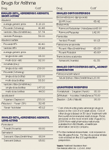Medication, self-monitoring recommended to control asthma
Several drug regimens are available for asthmatics, but the key to asthma control is to reduce airway inflammation, and therefore limit the need for short-term rescue medications.
Several drug regimens are available for asthmatics, but the key to asthma control is to reduce airway inflammation, and therefore limit the need for short-term rescue medications.
For reasons that aren't clear, the incidence of asthma has been increasing in recent years. According to the Centers for Disease Control, between 1980 and 1996 asthma increased 73.9%, with an estimated 14.6 million people in the United States reporting asthma during 1996, or 55 persons out of each 1,000.

"Inhaled corticosteroids, when used appropriately, are very effective, safe medications," Brueckl adds. "Some patients are afraid of them. This may be related to the controversy over misuse of anabolic steroids in athletics. Some patients may be confused and think all steroids are the same."
When asthma symptoms aren't fully controlled by an inhaled corticosteroid, and the patient is using a rescue medication more than twice a week, it is appropriate to add a long-acting beta2-agonist such as Foradil (formoterol) or Serevent (salmeterol). Formulations are available that combine inhaled corticosteroids and long-acting beta2-agonists.
Leukotriene modifiers are oral asthma medications that appear to be less effective than either an inhaled steroid, or an inhaled steroid/long-acting beta2-agonists combination. However, they are useful in patients with prominent exercise-induced symptoms, or those who have difficulty using an inhaler. They include Singulair (montelukast), Accolate (zafirlukast) and Zyflo (zileuton). "Singulair appears to be the safest leukotriene modifier for long-term use, and is less likely to cause drug-to-drug interactions than the other leukotriene modifiers," Dr. Abramowicz says.
HIGHER-COST TREATMENT For many patients, an allergic reaction triggers an asthma attack. For those with moderate-to-severe persistent asthma, the FDA has approved Xolair (omalizumab), a genetically engineered humanized monoclonal antibody that reduces allergic reactions and asthma attacks. It costs about $10,000 to $12,000 per year. "The high cost of this treatment, the need for subcutaneous injections, and concerns about its long-term safety probably will restrict its use to patients with severe asthma that is not adequately controlled by other drugs-and that has a clear allergic component," Dr. Abramowicz says.
Asthma treatment must go beyond medications. Attacks often are triggered by environmental allergens such as mold, pollen, dust mites, cockroaches and animal dander. That means the first step in treating asthma is to clean up the house and select non-allergenic furnishings, to limit environmental triggers as much as possible. Patients need to monitor their own lung function, using a peak expiratory flow meter, to identify constricted bronchial tubes. They need to take appropriate medications before actual symptoms appear.
Dupixent Is Linked to a Higher Risk of Psoriasis in Patients With Atopic Dermatitis
July 8th 2025AD and psoriasis were once thought to be opposites in terms of immune response, with AD linked to a Th2-dominant pathway and psoriasis driven by Th17 inflammation. However, newer research has shown that these diseases can overlap in patients and may even share common pathways.
Read More
David Calabrese of OptumRx Talks New Role, Market Insulin Prices and Other Topics 'On His Mind'
April 13th 2023In this month’s episode of the "What's On Your Mind podcast," Peter Wehrwein, managing editor of MHE connects with the now Chief Clinical Officer of OptumRx Integrated Pharmacies, David Calabrese. In this conversation, David touches on his transition in January as OptumRx’s former chief pharmacy officer and market president of health plans and PBMs to his new role as Chief Clinical Officer where he now focuses more on things such as specialty pharmacy to home delivery — with an overall goal of creating whole-patient care. Throughout the conversation, Calabrese also touched on the market’s hot topic of insulin prices and behavioral health services within the OptumRx community, among other topics.
Listen
Briana Contreras, editor of Managed Healthcare Executive, spoke with Nancy Lurker, CEO and president of EyePoint Pharmaceuticals. Nancy shared a bit about EyePoint and how the organization’s innovative therapies are addressing patient needs through eye care, and most importantly, she addressed C-Suite positions like the CEO role. Nancy shared advice for those seeking to reach the CEO level, especially toward women in healthcare and other roles, and what it takes to run a biopharma company.
Listen